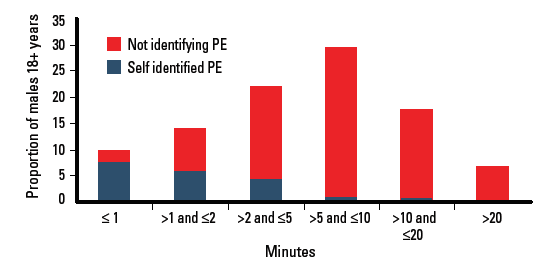In BEACH (Bettering the Evaluation and Care of Health), between April 2007 and March 2012, PE was managed at only 28 per 100 000 encounters with adult male patients. In December 2008 to January 2009 we conducted a sub-study4 of the BEACH program to measure the prevalence of PE among male general practice patients and to examine the effectiveness of the Premature Ejaculation Diagnostic Tool5 (PEDT) in identifying those with PE.
Eighty-three general practitioners participated in the study, with a total sample of 796 adult males (aged 18+ years), 656 of whom completed questions about their sexual activity. Of these, 57.5% reported being currently sexually active, 39.5% were previously sexually active, and 2.7% had never been sexually active. Self perceived PE status was recorded by 463 (72.6%) of the 638 currently/previously sexually active males. Of these, 18.1% (n=84) felt they had PE and 81.9% (n=379) felt they did not. Of the 84 patients with PE, 45.2% (n=38) reported they had always (or nearly always) had PE since their first sexual contact, 42.9% (n=36) developed consistent PE ‘at a certain age’, and 11.9% (n=10) developed consistent PE at the time of, or after, experiencing erectile dysfunction.
Of the 638 currently/previously sexually active patients, time to ejaculation after penetration was recorded for 420 (65.8%). One-quarter (n=101) reported ejaculation within 2 minutes, and three-quarters reported ejaculation more than 2 minutes after penetration (Figure 1). Of the 82 patients who self reported PE and responded to this question, 57 (69.5%) reported ejaculation within 2 minutes of penetration. Of the 338 patients who felt they did not have PE and responded to this question, 44 (13.0%) reported ejaculation within 2 minutes of penetration.
The five questions that form the PEDT ask about the patient’s subjective experience of sexual intercourse and were answered by 416 currently/previously sexually active adult male patients. The PEDT scores for 81 patients who felt they had PE suggested 77.8% did have PE, 7.4% (n=6) had possible PE, and 14.8% (n=12) did not. The PEDT scores for 335 patients who did not self report PE suggested 3.6% (n=12) did have PE, 8.7% (n=29) had possible PE, and 87.8% did not. Our study has shown that while PE is rarely managed in general practice, nearly one-in-five male adult patients seeing a GP reports experiencing it. This suggests that GPs should consider raising this issue with their male patients. The PEDT has been shown to be accurate, and may help GPs broach this sensitive subject.

Figure 1. Average length of time to ejaculation (in minutes) by self identified premature ejaculation status
Competing interests: None.
Provenance and peer review: Commissioned; not peer reviewed.
Acknowledgements
The authors thank the GP participants in the BEACH program and all members of the BEACH team. Financial contributors to BEACH in 2008–2009: Australian Government Department of Health and Ageing; Australian Institute of Health and Welfare; National Prescribing Service; AstraZeneca Pty Ltd (Australia); Janssen-Cilag Pty Ltd; Merck Sharp & Dohme (Australia) Pty Ltd; Pfizer Australia; Abbott Australasia; Sanofi-Aventis Australia Pty Ltd; Wyeth Australia Pty Ltd. In particular we would like to thank Janssen-Cilag who collaborated with the BEACH team on this study.